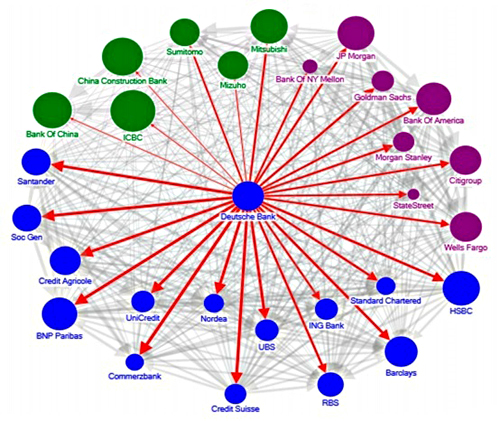Courtesy of Pam Martens
Systemic Risk Among Deutsche Bank and Global Systemically Important Banks (Source: IMF — “The blue, purple and green nodes denote European, US and Asian banks, respectively. The thickness of the arrows capture total linkages (both inward and outward), and the arrow captures the direction of net spillover. The size of the nodes reflects asset size.”)
By Pam Martens and Russ Martens
Today’s front page of the print edition of the New York Times has articles on the Oscars, the election in Italy, Ben Carson’s reign at HUD and the death of an elderly Briton who once broke the four-minute mile among numerous other less than urgent news pieces. What it does not have on its front page is any headline showing concern that the seminal piece of Wall Street reform legislation of the Obama era, which already has enough loopholes to set off champagne corks on K Street, may be dismantled this week by a vote in the Senate. The move would come in the midst of the 10th anniversary of the greatest Wall Street collapse and economic catastrophe since the Great Depression, both of which were underpinned by casino capitalism — Wall Street banks making obscenely leveraged bets for the house while holding Mom and Pop deposits.
This is now the new normal at the New York Times with its editorial page editor declaring in December at a staff meeting that the paper is “pro-capitalism.” This is really code for “Wall Street is our home-town team and we’re not going to bite the hand that feeds us” – even if it means intentionally rewriting the facts on what actually caused the Wall Street crash.
Instead of calling front page attention to the ongoing critical threat to the nation’s financial system and providing an in-depth analysis of how Wall Street has already whittled down the 2010 Dodd-Frank financial reform legislation by a thousand cuts, the Times buried its tepid article on page B1under the headline: “Big Banks May Weaken Dodd-Frank Oversight.”
Citigroup was the poster child of the 2008 financial crash. It had loaded up on dodgy off-balance sheet “assets,” lied about its subprime debt exposure, and then received the largest taxpayer bailout in U.S. history. In December 2014 Congress allowed Citigroup to take a chain saw to Dodd-Frank. Citigroup pushed through a measure in the must-pass spending bill to keep the government running that allowed it and the other biggest banks on Wall Street to keep their riskiest assets – derivatives – in the commercial banking unit that is backstopped with FDIC deposit insurance. The taxpayer-subsidized deposit insurance allows the mega banks to get a higher credit rating than they would otherwise receive while paying pathetically low interest rates to savers on those deposits. By holding tens of trillions of dollars in derivatives on their respective commercial bank books, the mega banks are perceived as too-big-to-fail and can put a gun to the head of taxpayers for another bailout the next time their risky bets fail. All of these tricks are effectively public subsidies of a banking system gone mad.
…




